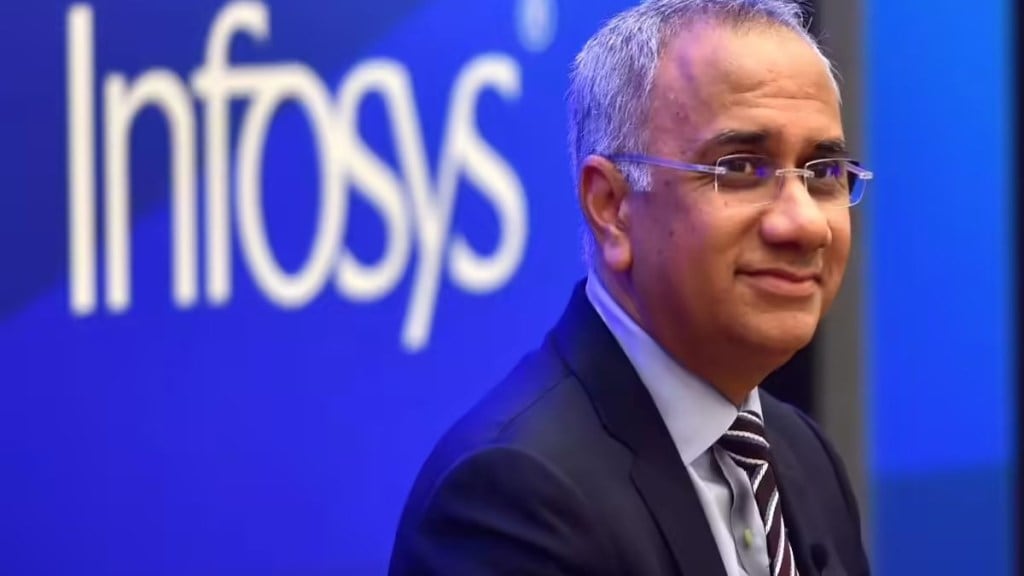Infosys, the country’s second-largest IT services firm, logged better-than-expected performance in the second quarter of the current financial year, with both revenue and net profit beating Bloomberg estimates.
After two consecutive quarters of strong growth, the IT major on Thursday revised the lower end of its revenue growth guidance for FY26 to 2% from 1%. It maintained its upper bound at 3% and left its operating margin guidance unchanged at 20–22%. It cited improved visibility and strong deal wins for narrowing the growth guidance, even as the macroeconomic situation remained unstable.
Its consolidated revenue for the quarter rose 5.2% sequentially to 44, 490 crore (Q1:42,279 crore), exceeding the estimates of 44,008 crore. Net profit grew 6.4% quarter-on-quarter to7,364 crore (Q1: 6,921 crore) and was above the Street estimates of7,224 crore.
“We have now delivered two consecutive quarters of strong growth, demonstrating our unique market positioning and client relevance. Strong deal wins, with 67% net new in Q2, reflect our deep understanding of clients’ priorities to deliver value from AI in this environment,” said Salil Parekh, CEO and MD, Infosys.
Revenue grew 2.2% sequentially in constant currency terms and operating margin came in at 21% for the September quarter. Large deal order book value for the quarter was $3.2 billion, with 67% coming from net new wins, the firm said in its earnings release. In Q1, Infosys signed $3.8 billion worth of large deals, 55% of which were net new.
“We had robust all-round performance in Q2 — strong growth, resilient margins, very high cash generation and 13.1% EPS (earnings per share) growth year-on-year in rupee terms. We continue to make strategic investments to future-proof the business with a tight focus on execution, amidst high uncertainty,” CFO Jayesh Sanghrajka said.
He added that in line with its capital allocation policy, the IT major announced a share buyback for 18,000 crore during the quarter and an interim dividend of23 per share, an increase of 9.5% over the last financial year.
“If you look at last year, we expanded margin by 50 basis points, despite multiple headwinds. Even this quarter, we expanded margin by 50 basis points sequentially, and the Project Maximus has delivered 30 basis points out of that, where pricing gave us a tailwind, and that was offset by higher sub-con and lower on-site utilisation,” Sanghrajka added.
The number of active clients rose by 35, reaching 1,896 on-quarter while the number of $10-million clients rose by 5 to 322. The company management said that the firm has benefited from clients consolidating vendors, and embarking on cost optimisation.
Parekh said that Infosys will continue its asset-light strategy when it comes to pivoting to AI, adding that clients have shown interest in AI-led projects for both growth and cost optimisation. He, however, said that the firm will refrain from calling out AI revenues or their contribution to the top line for now.
“Our focus will be to share what we’re doing on AI currently. We, of course, track all of that (AI revenue metrics) internally. And as the right time comes, we will start to share that externally,” Parekh said. On Thursday, Infosys shares closed 0.8% lower at Rs 1,472.75 on the BSE. The quarterly results were announced after market hours.
Geography- and vertical- wise performance
After modest growth of 0.5% year-on-year in constant currency from the North American market in Q1, Infosys saw growth ramp up to 2% in the core market in the September quarter. North America contributes over half the IT firm’s revenue.
Growth in Europe, by contrast, slowed down to 6.3% (Q1: 16.2%) while India grew 6.8%. The rest of the world declined 3.9%.
Among the verticals, hi-tech showed the largest growth at 8.6%, followed by manufacturing (6.6%) and financial services (5.4%). Life sciences showed the maximum decline annually at 10.5%. Retail also declined 2.3%.
Employee metrics
Infosys was a clear leader among large cap peers Tata Consultancy Services, Wipro and HCLTech in terms of headcount addition, growing its workforce by 8,203 in the second quarter. Voluntary attrition declined marginally to 14.3% (Q1: 14.4%), though remained much higher than 12.9% a year ago.
On-site workforce deployment reduced marginally to 23.2% (Q1: 23.6%), and utilisation (excluding trainees) was down slightly at 85.1% (Q1: 85.2%). While the firm did not disclose fresher hiring numbers for the quarter, Sanghrajka said that the cumulative fresher hiring for H1 was around 12, 000, implying that the company will meet its guidance of hiring 15, 000 freshers this fiscal.
On H1-B, Parekh echoed peers’ confidence regarding limited impact of recent policy changes by the US government stressing that Infosys’ dependence on the visa is minimal. “Only a minority of our US workforce requires Infosys sponsorship for immigration. Near-shore is a huge success for us.
Many years ago, we started the approach within a strategy of localisation in each of our geographies… that part has really gone extremely well and we feel quite confident that that we will scale even further with all the changes,” Parekh said.
He added that Infosys has built a centres and hubs which are focused on digital innovation and technology and AI in the US it has development relationships with universities and has a training facility there. It has also engaged with clients in the market to ensure that delivery continuity remains on track.
“With all of that in mind, we are clear today that we will work with our clients without any disruption to their services and into the future,” he added.

